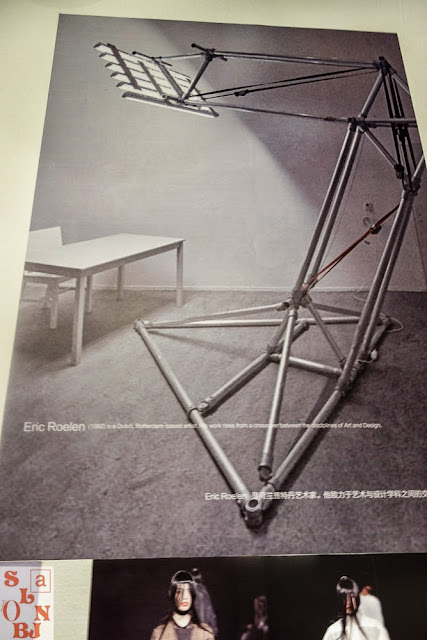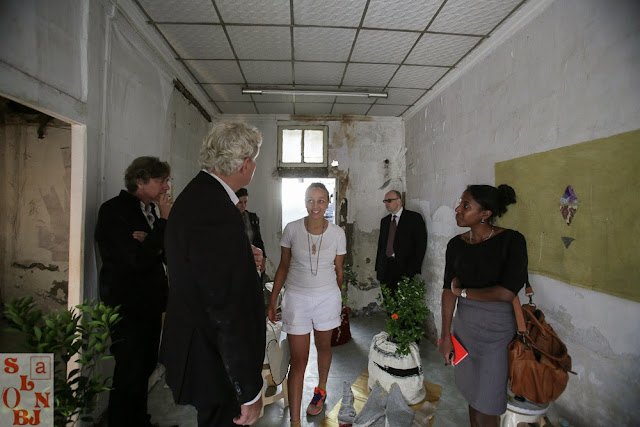Edo Dijksterhuis writes about SALON/BJ for the Creative Industries Fund NL blog.
Daily report from the Beijing Design Week | 26 September 2013
From 26 September to 3
October the Creative Industries Fund NL will publish daily reports on
the website covering the Dutch creative industries at the Beijing Design
Week.
Today's report focuses on Salon/BJ. Supported by the Creative Industries Internationalization Programme.
Report by: Edo Dijksterhuis
Photography: JW Kaldenbach

Pay attention and you’ll spot them all over Beijing: mops.
Often made out of a shirt torn into strips, or from towels discarded
from a massage parlour, or even the leftovers of exhausted supplies.
They immediately caught the eye of Ernst van der Hoeven, designer by
profession but beachcomber by calling. He collected old mops in exchange
for new ones, or for cash. What he did with the sixty floor cloths
attached to poles that he eventually collected, containing years of
grime from all corners and crevices of the neighbourhood, was tie them
together to form a colourful bouquet. Suspended upside down, those
commonplace rags transform into an elegant, supersized calligraphy
brush.
SALON/BJ
This is a typical project by Salon, the interdisciplinary platform for
design, fashion and art in Amsterdam. Gijs Stork and Manon Schaap, the
initiators, started Salon in 2010 to dismantle the fences separating the
various disciplines and place creative cross-pollination firmly in the
middle of the real world. After a successful showing in Istanbul late
last year, the Salon has now landed in Dashilar, a so-called ‘hutong’ in
the heart of Beijing, as part of Beijing Design Week.
Van der Hoeven has made a sort of mascot for the old working-class
district with his giant brush. Bureau Lava does something similar, but
on another level. With a mobile studio that looks a lot like a
Popemobile made of metal, they go along the local traders and design
logos for them. Identity and branding are self-explanatory in the
Netherlands — Lava can thank much of its twenty-year existence to them —
but here in these surroundings dominated by small and anonymous shops
packed with generic mass-produced articles, they can be considered a
minor revolution.
A recipe for embedding everything in the local context
The Dutch participants at
Salon Beijing
— as well as some Chinese counterparts — were asked to take as little
material as possible with them from home. In fact, their baggage was
only supposed to consist of an idea. Apart from that, they had to use
whatever items and people they could find here. That was a recipe for
embedding everything in the local context, and a tough challenge it was
too. For they had just one week not only to get their work and
exhibition space ready — vacant dwellings, small factories and shops —
but also to find materials, source suppliers and get their idea
produced.
Local materials turn out to be a fantastic source of inspiration for
reuse with a twist. Frank Bruggeman combined thermos flasks and
disposable hats with dried lotuses and kitschy plastic roses to make a
suspended sculpture. Henny van Nistelrooy unravelled a length of thick,
woven fabric to make a hammock. Eric Roelen stuck sturdy-looking
cabinets together with bright pink polystyrene foam. Desirée Hammen drew
inspiration from the T’ai Chi philosophy of soft force and used the
marigolds growing all over Dashilar to make dye for clothing. And the
Noman duo rendered the irregularities in the local street pattern
visible by clasping bamboo stakes in a rhythmical arrangement between
floor and ceiling.
For some designers, Salon BJ offers an opportunity to rework previous
designs or develop them further. Borre Akkersdijk applied his
circular-knitting technique, with which he has already come up with
innovative textiles, to fabrics found on location. Chris Kabel took the
circular wooden bench he designed in 2010 for the Witte de With centre
and made it out of a typical Chinese raw material: two-hundred plastic
stools that he had painted in a colour scale from white to red in a tiny
factory. The duo rENs, who have been researching the colour red for
years, got the local school of fashion to make basic blouses so that
they could immerse them in traditional vats of paint in a
laboratory-like setting. And Elisa van Jolen, always interested in
production processes and their underlying value patterns, pulled locally
manufactured sports shoes inside out to reveal the stitching of
anonymous factory workers.
A practical do-and-show approach
The reflexive side is balanced by the practical do-and-show approach.
For instance, Conny Groenewegen considered the nomad who populates
Beijing and what he might be wearing. Femke de Vries examined the role
of textile in delineating space — a current theme in a neighbourhood
where families occupy an average of twelve square metres of living
space. And illustrator Jan Rothuizen took a close look at the
neighbourhood and hung his ‘mental map’ next to a drawing made in
Amsterdam showing the accommodation occupied by an illegal Chinese
resident there.
Dialogue on as many levels as possible: that’s what the Salon is about.
In that sense, Dashilar was a fortunate choice of location. Its
six-hundred-year history makes it just as old as Amsterdam. And like the
Jordaan district, it was primed for demolition for a long time.
However, the authorities realized in time that a little variation in the
urban landscape is invigorating. The densely populated neighbourhood
has dynamic climate of working and living that is all of its own.
Sander Wassink makes of the most of that. He bought heaps of fake
counterfeit shoes made in local sweatshops, cut them up, and stuck the
pieces together again to create new, futuristic-looking models.
Shoemakers working on nearby streets did the stitching and sometimes
added an idea of their own too.
Klaas Kuiken and Dieter Volkers took the idea of co-creation a step
further. They asked a fishmonger around the corner, a butcher, a
79-year-old grandmother passing by, and a girl of 13 living nearby to
each make a small teapot from a ball of clay. Their creations are
displayed in a drying cabinet, with their photograph and personal
details hanging on the wall next to them to create a double portrait.
For Kuiken and Volkers, it is about personalizing what is usually an
anonymous utensil, as well as about designing an archetype. Their plan
is, once back in the Netherlands, to scan all sculptures made in
Dashilar and lay them over one another so that they merge to form an
average: a portrait of a neighbourhood in the form of a teapot.
Via & Dutch translation







































































